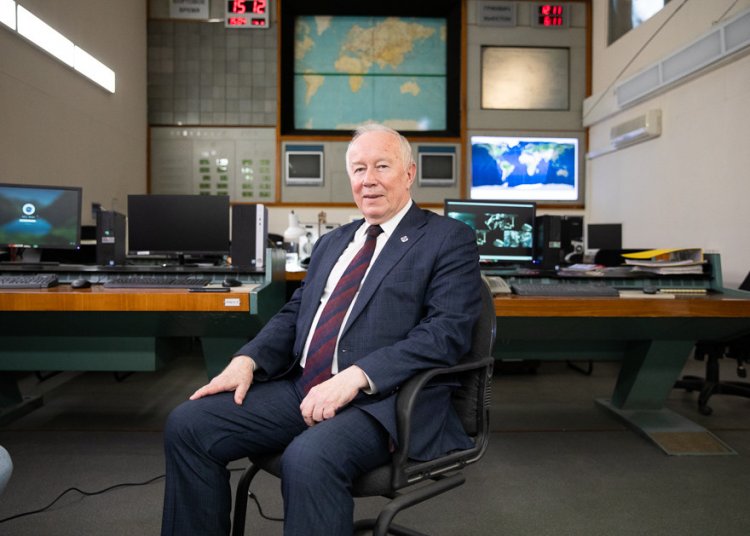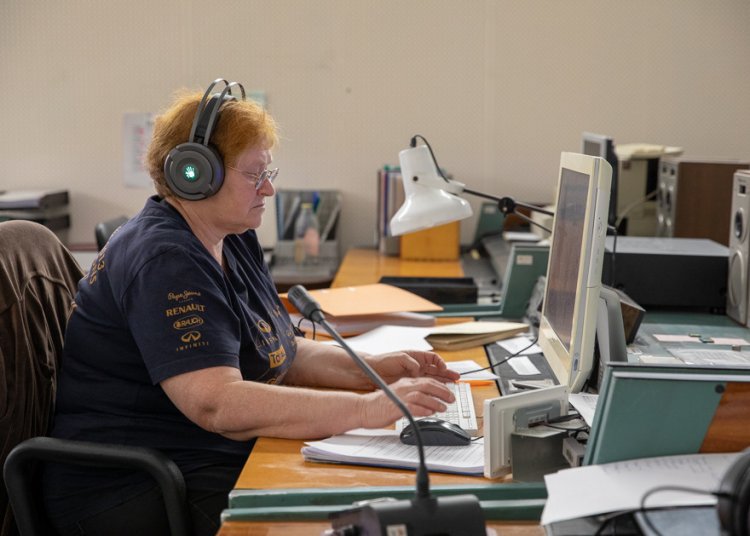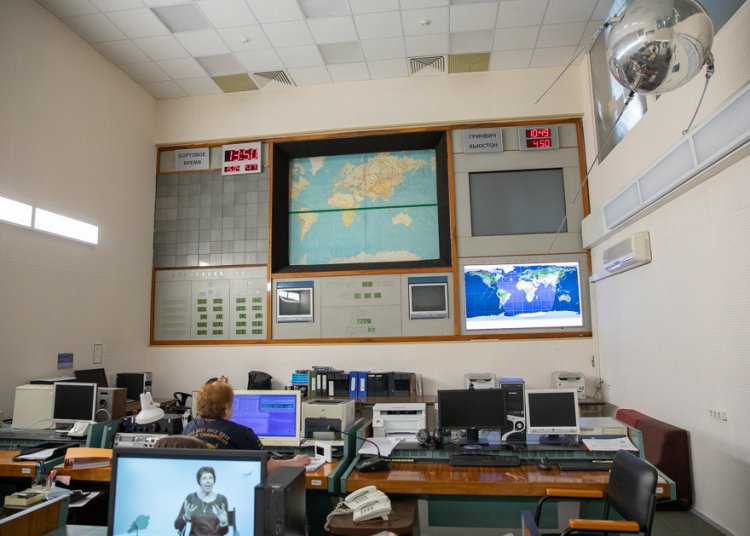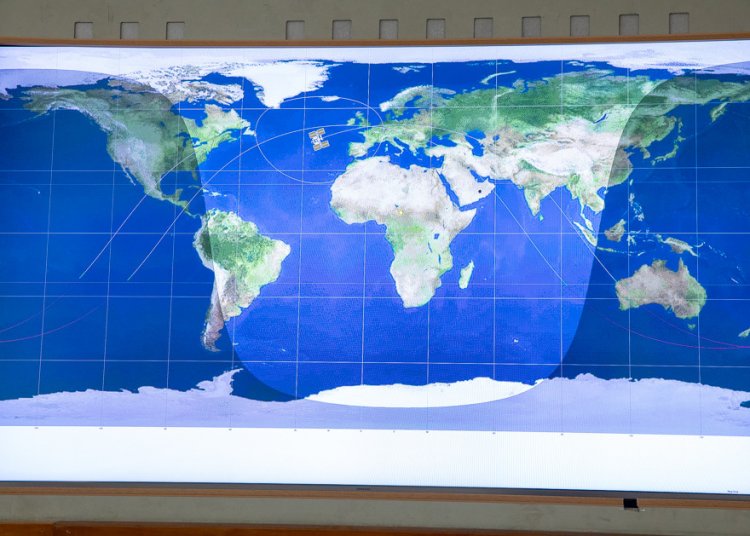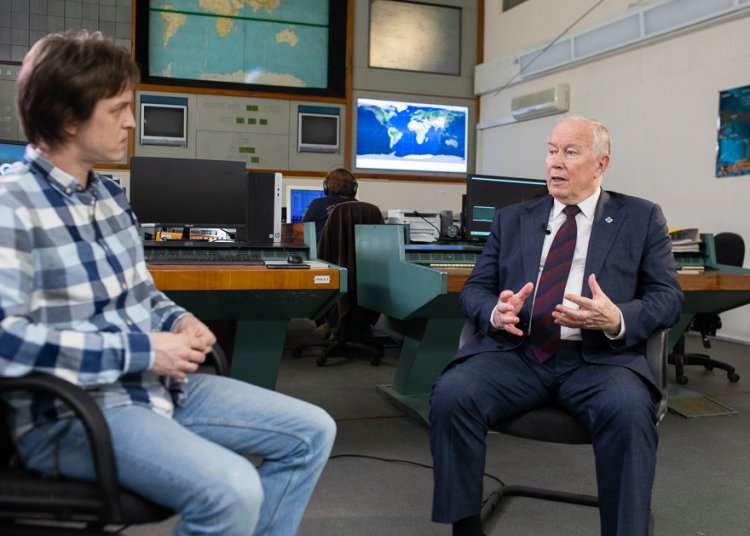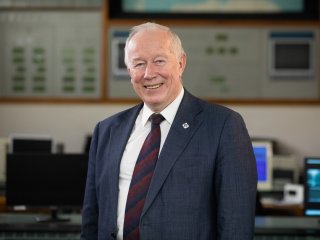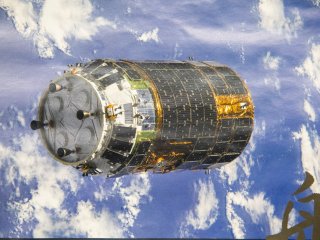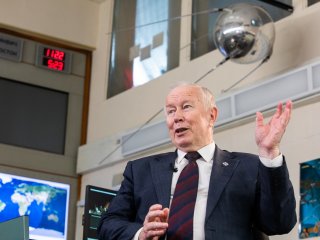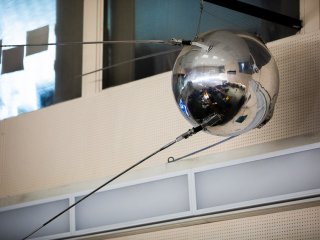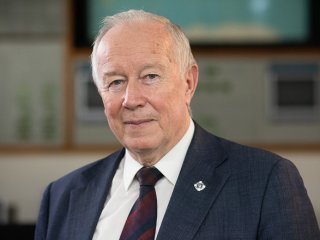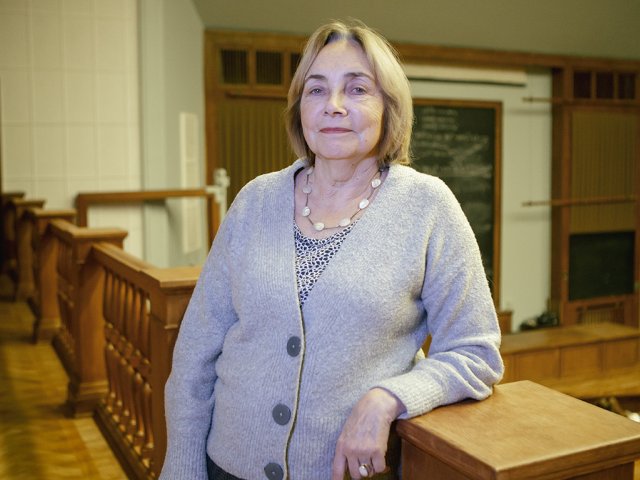On the calendar of the Year of Science and Technology, April was chosen as Space Exploration Month. The Institute of Biomedical Problems, founded two years after Yuri Gagarin’s space flight, has been studying how space flights affect human health since the mid-1960s.
We have discussed the history and prospects of space medicine with RAS Academician Victor Mikhailovich Baranov, in the very building where life support systems for spaceships and on-orbit stations providing temperature control, water recycling, and carbon dioxide absorption were tested.
How were space life support systems developing? Can non-professionals be sent to space? What is the current orientation in space medicine? Which specialists are needed in the industry? These questions were touched upon in the interview conducted at the Institute of Biomedical Problems in light of the 60th anniversary of the first manned space flight.
RAS Academician Victor Mikhailovich Baranov
Photo: Nikolay Mokhnachev / Scientific Russia
- The institute opened in 1963. Six Soviet cosmonauts had been to space and back by then – a confirmation that humans could travel beyond the atmosphere and come back. What were the challenges that the space medicine sector was facing back then?
- The first flights showed that a person could stay in space for a relatively short time. Sergey Palvovich Korolev was expanding the tasks then and included the possibility of living on the orbit for a long period of time. That is, they were thinking about on-orbit stations as early as that.
Prior to his space flight, Yuri Gagarin was trained at the Aviation Medicine Institute. This is a defense sector institute with appropriate activities. Sergey Korolev and Mstislav Keldysh, President of the Academy of Sciences, initiated a new institute to complete new tasks. On November 4, 1963, the Ministry of Healthcare issued a directive; nobody knew what the new institute would be called but there was one goal: to start investigating space flights. The first flights showed that humans could be in space, but nearly all mechanisms of that “stay” were unclear: there were registered adverse impacts of zero gravity and space flight factors, which required research.
Long space flights were being prepared already; as early as 1967, the Institute of Biomedical Problems started a 12-month experiment involving medico-technical testing of life support systems for on-orbit stations.
The experiment was run in an altitude-chamber that had much lower capacity compared to today’s altitude-chambers or on-orbit stations – around 40 m3. Three testers spent a year there – the physician Hermann Manovtsev was captain, Boris Ulybyshev – technician, Andrey Bozhko – biologist. The guys had a bit of a “bad luck” – it was a leap year, so they spent 366 days in the altitude-chamber instead of 365. During that period, they tested life support systems developed for future stations – the experiment confirmed their effectiveness and proved that they would make long space flights possible.
The flight by Andriyan Nikolaev and Vitaly Sevastianov showed that a prevention system was needed. The Soyuz-9 mission lasted 17.5 days; the flight showed that without preventive measures, cosmonauts came back to Earth in a poor physical state – they could not sustain loads very well and had issues with orthostatic stability – the ability to keep vertical balance. Some people were saying that those problems could not be solved, but that was what the Institute of Biomedical Problems was created for in the first place. Jointly with the Aviation Medicine Institute and the Cosmonaut Training Center, IBMP developed a system to prevent negative effects of zero gravity quite soon. Research was conducted in parallel with efforts to complete practical tasks: means had to be produced that would enable cosmonauts to follow doctors’ orders.
Photo: Nikolay Mokhnachev / Scientific Russia
Cosmonauts’ communications being reviewed at the IBMP Photo: Nikolay Mokhnachev / Scientific Russia
Even the first on-orbit station had some prevention equipment. The flight to the station ended tragically – three wonderful cosmonauts were killed: Dobrovolsky, Patsaev and Volkov (the second expedition to the Salyut-1 on-orbit station in 1971. The crew of the Soyuz-11 mission spent 22 days at the station and completed the flight program successfully. After the undocking and the retrograde deorbit burn, the spaceship began descending from the orbit. When the compartments were detached, the descending spaceship lost pressure, and the crew died at the descent and landing stage. – Ed.). Back then, some specialists had doubts regarding the reliability of the new life support systems and attributed the cosmonauts’ death to zero gravity. Now we know that the problem was depressurization.
The research at on-orbit stations continued with the Institute playing the leading role and getting different organizations together to do what was needed. In 1978, a team of specialists led by of the Institute Director, Oleg Georgievich Gazenko, received the State Award for designing a prevention system that was subsequently used for space flights.
The biological satellite research program started at the same time. Cosmonauts were monitored, examined before and after the flights, but deep mechanisms could only be understood by examining the biological objects during a flight. The knowledge of the effects of zero gravity was growing; there came the understanding of what must be done to neutralize the negative effects.
The Mir station became the crown of space medicine with all its medical equipment designed specifically for those tasks. It was at the Mir station that cosmonaut Valery Polyakov carried out the longest single spaceflight in history, which lasted 438 days. I went to meet him at the landing location, and the first thing he said as we were pulling him out of the craft was: “Victor, we’ve proven that we could fly to Mars.” It was proven that there was a system of preventing the adverse effects of zero gravity, and that it was effective provided that all the relevant recommendations were followed.
What makes this prevention difficult is that the physical exercise took a long time – the cosmonauts had to work out for about 2.5 hours a day. Therefore, our specialists are looking for alternative methods: those could be used as complementary or during some parts of the flight. That is the job of a department that was led by Inesa Benediktovna Kozlovskaya – a spirited and talented woman, who performed basic research regarding the neuromuscular system and sensorineural research.
We held a meeting 20 years ago, on the topic: “Could the existing life support systems be used for flights beyond the orbits of Earth?” Experts showed that it could be done if certain conditions were met – life support systems have gone a long way from stocks and provisions systems where cosmonauts had to bring oxygen and the water for the recycling systems, both oxygen and water now being available at the space station. Biological systems should be a most important link in the system of life support for cosmonauts.
The position of the ISS is displayed live
Photo: Nikolay Mokhnachev / Scientific Russia
- What conditions have to be met to conduct long space flights on existing spacecraft?
- There must be medical support system operating under autonomous conditions: if anything happens on the Earth orbit, the crew can go back to Earth within 3 to 6 hours. This couldn’t be done during flights to the nearest planets or moons.
The crew must include a physician. There are different opinions as to the specialization of such doctor, since they could not possibly be a specialist in everything. I believe, it should be an intensive care doctor. Someone who would be able to help with acute conditions, and then treat the patient using communication with Earth or a handbook. There must be a medical support system.
Radiation is a critical factor. If we don’t learn how to neutralize it, there’ll be difficulties with long space flights. Now, it is Problem No. 1 with regard to flights to the Moon or Mars. Moreover, there is moon dust on the Moon: the Americans’ flight showed it to be a serious issue in terms of cosmonauts’ health. The composition of the dust is known as Russian, American and Chinese scientists have samples of it. It’s important to prevent the dust getting in the ship and therefore in cosmonauts’ respiratory organs or eyes. And we need to understand what to do if it does happen.
We also need to solve the issues relating to the exposure to changed gravity conditions. The Moon’s gravity is 1/6 as powerful as Earth gravity, while Mars has 38% of Earth's gravity, which means different biomechanics of breathing and movements – primarily movements on the surface. We need equipment for moving and working in hypogravity, which is something between Earth's gravity and zero gravity.
Besides, autonomy and communication delays may affect relationship among team members. That is there is a whole set of problems and, essentially, what’s required is a new healthcare support system for expeditions.
- What alternatives to two-hour physical training sessions do scientists propose?
- Muscle electrostimulation, for example. Electrodes are attached, an electric current is put through, and the muscles contract, basically simulating activity. The procedure isn’t that pleasant, but some cosmonauts even liked it. And this procedure allows one to work.
Foot pneumostimulation has shown an excellent effect as well. There are special shoes with 256 points stimulating the foot. Various stimulation speeds allow one to simulate foot movements from walking to running. When we walk on Earth, impulses from Vater-Pacini corpuscles go to the spinal cord and further up. They close on the spinal cord level, the information is analyzed by the nervous system, and the returning control pulse is sent. When we don’t receive this feedback information while in zero gravity, that results in changes in the muscles, deconditioning. This machine helps the body compensate for the lack of proprioceptive information. It is also good for the rehabilitation of patients recovering after a stroke.
- What other space developments are used in civil medicine?
- It would be hard to list them all. When Yevgeny Ivanovich Chazov was the Minister of Healthcare, the ministry organized an exhibition called Space Medicine for Practical Healthcare. The institute presented around eighty proposed products then. There is a wide application area for space medicine products in civil healthcare.
For instance, in physiology and rehabilitation of patients. Jointly with colleagues from other organizations, the IBMP developed the Penguin suit with in-built shock absorbers, which helps maintain a particular posture. It became the basis for special suits for infantile cerebral paralysis patients. There is a system of centers where those suits are used and improved, and where new ones are developed. They are most effective. If the institute had done nothing but this suit, it would have been an excellent result for practical healthcare.
Biotechnologies are developing as well – the use of zero gravity to produce more pure medicinal drugs. Onboard the ISS, our cosmonauts experiment with crystallizers. For instance, when a protein crystal is grown on Earth, gravity prevents the crystal to become large or sufficiently regular in shape, while zero gravity allows it.
A heat-shock crystal has been grown. It has a cytostatic effect, i.e., prevents a cell from multiplying. That means it might be useful in treating cancer. Once we have examined it, learned its structure and started reproducing it, there’ll be a chance to create a new medication.
There is a committee for peaceful space issues under the United Nations, with a separate international group Space and Health. A lot depends on the tasks that practical healthcare puts before the space sector. There should be joint meetings and conferences. Students should be taught in a manner that would make them understand while still studying what the space sector could go for practical medicine. We have very few college departments for such issues – we have to work on that.
Photo: Nikolay Mokhnachev / Scientific Russia
- How enthusiastic are young specialists about working in space medicine?
- You can see a lot of young people at the institute, though I can’t say it is highly popular. The problem is space travel itself: people used to dream of becoming cosmonauts, and the competition was much tougher.
Students take postgraduate training and want to work in space medicine, especially specialists in molecular genetics research. The objectives for space medicine are now changing in line with the federal space program, and I think the sector is going to attract more people.
- What kind of specialists are needed in space medicine now? Surgeons, general practitioners, virologists...
- There is this term “Life Sciences.” At the present stage, space medicine is preventive. One has to be healthy to fly to space; there is tough selection.
Surgeons and general practitioners are specialists in medical treatment. We should use their experience, but they should know what space medicine is. I would build a group of expert physicians who know the distinct features of diseases in zero gravity: they do exist. It’s personalized medicine – what we’ve come to on Earth: treat the person, not the disease.
I would strengthen the molecular-genetic branch of space medicine. Because it works with radiation, with individual sensitivity to the impact of radiation. We need more advanced knowledge, which would enable us to predict the effects of a long space flight on a cosmonaut’s health. There is a lot of cellular and molecular-genetic research projects at the institute at the moment.
– Cosmonauts are subjected to tough medical selection, but now there is a plan to make a movie at the ISS. They are looking for an actress; the film crew is likely to fly as well, i.e., a team of non-professionals are going to fly to space. Is this realistic now?
-We saw that it was realistic when tourists began flying to space, and not just one. They were examined, of course, but all of them had certain health issues.
The average age of Squad 1 cosmonauts is 34 to 38 years. While today, the average age of active cosmonauts is 48 years – a 10-year difference. The reason is that cosmonauts now do research and operate complex systems. It takes time to train an expert scientist or an engineer, and it’s hard to find a 50-year-old in perfect health.
There are discussions, debates going on now: it’s being said that we have to change the approach to health assessment. Especially for a short flight. For instance, allowing people with partial health deficiencies to fly to space is being suggested. But the doctors must know about health issues and be prepared to help – health issues must not be concealed. For example, if a specialist who is to fly to space, has hypertension, doctors should give them medication and recommendations. The person should not conceal health issues, bring some medication with them in secret and take it if things go wrong – we have to know and solve such problems openly.
- You mean, space medicine opens the orbit to civilians?
- We have to do it. Moreover, if we are starting suborbital flights (those are not space flights), the tourist would have to fly for as little as 1.5 to 3 hours, and there has to be a special clearance system. The difference is the same as between military and civil aviation, i.e., serious overloads vs. a 19-hour flight from New York to Singapore.
– To sum things up: what is the main focus of space medicine in Russia? Is the main goal to go beyond the Earth’s magnetic field?
- Space medicine is a science supporting the manned space flight program. It depends of the federal space program, the goals of Roscosmos, and ideas of the chief designers. The main thing for space medicine now is the flight to the Moon. If we solve this problem, that will make it easier to handle the flight to Mars.
There should be specific goals and objectives: why are we going to the Moon or Mars? Specialists in space research would determine what we have to gain from those flights. And our modest job is to ensure that the cosmonaut is healthy, that they will get help is anything goes wrong during the flight, and that they can recover and rejoin the working crew again.
The interview with RAS Academician Victor Mikhailovich Baranov
The interview was conducted at IBMP with the support from the Ministry of Science and Higher Education of the Russian Federation and the Russian Academy of Sciences.
